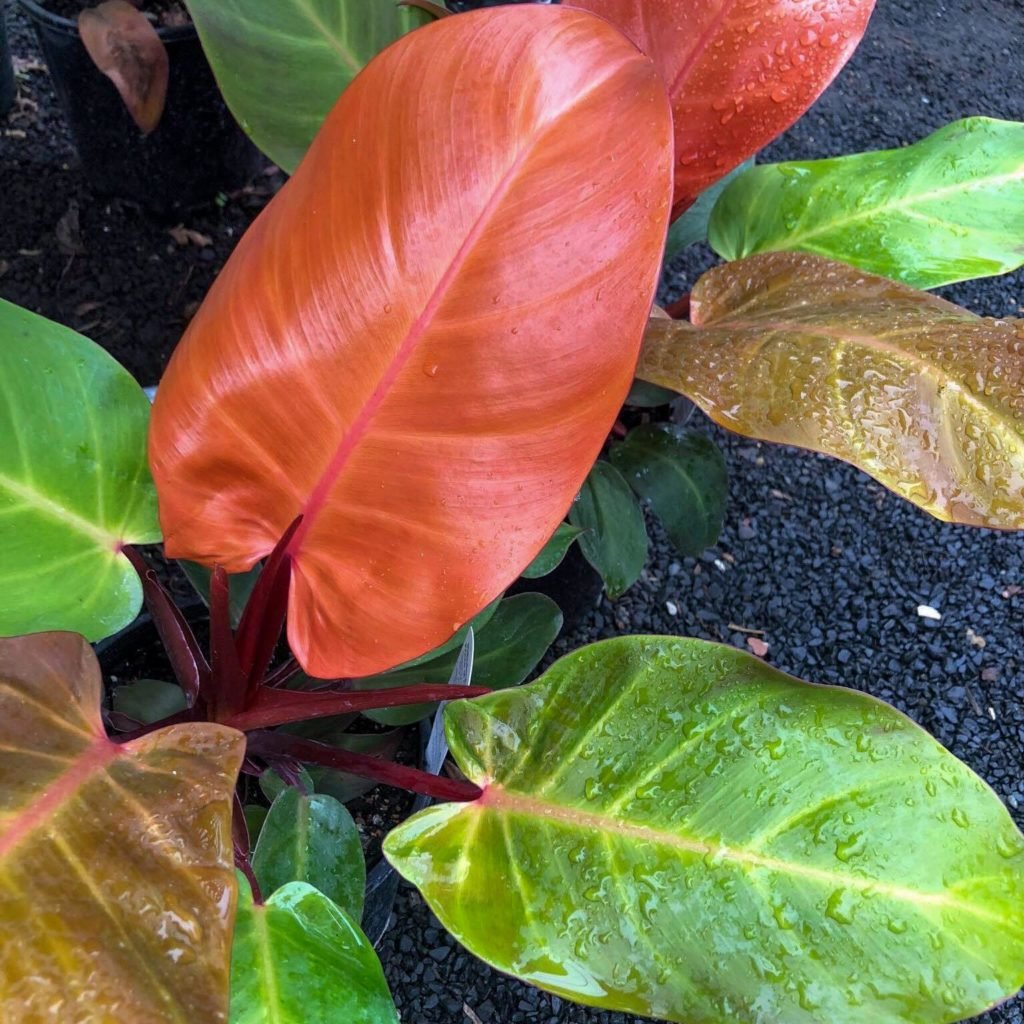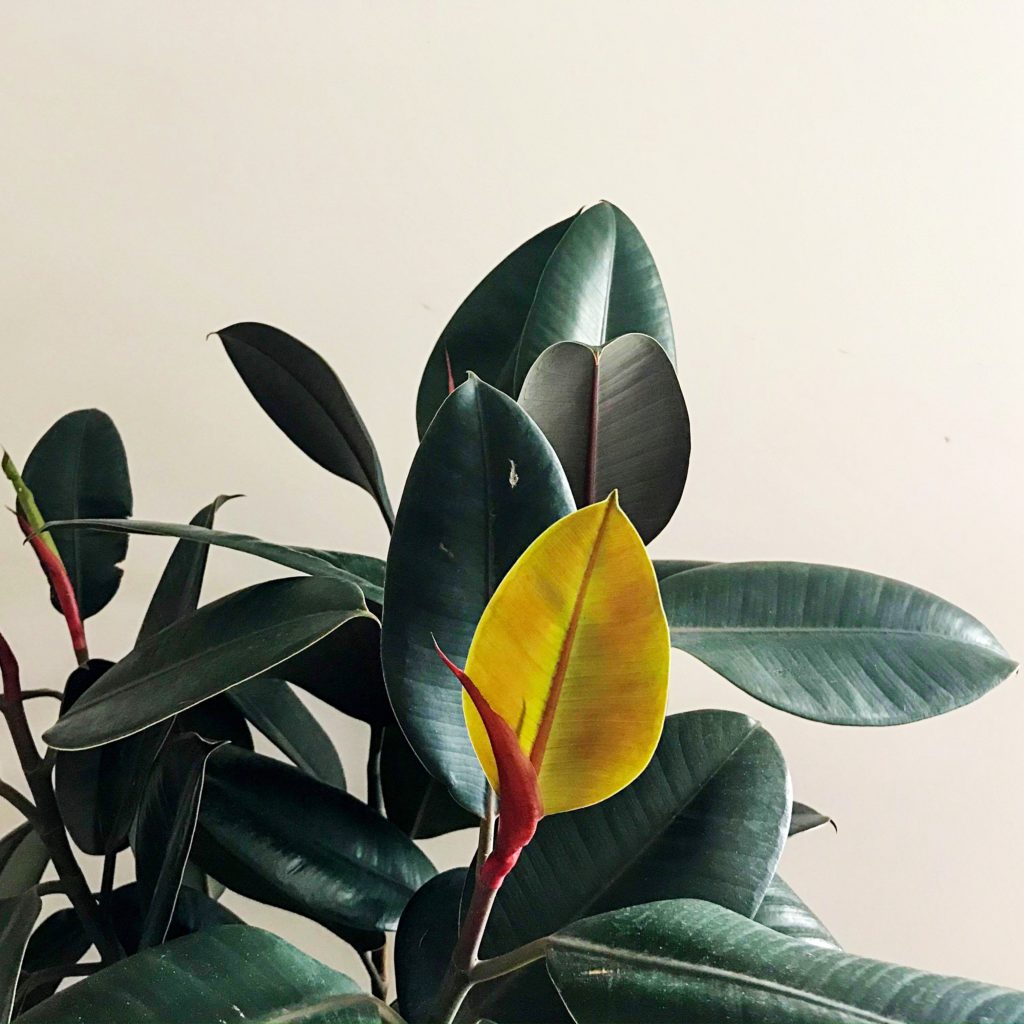Philodendron Erubescens ‘Prince of Orange’ a.k.a Philodendron Prince of Orange
The Philodendron Prince of Orange is a hybrid Philodendron variety with vibrant orange leaves. Their cousin the Imperial Gold Philodendron that also have orange hued leaves fails to compare to this plant when it come to vibrancy of colour. This plant is a fast grower that is pretty easy to care for and is an overall gorgeous plant to have in your collection.
This plant is a hybrid Philodendron that is part of the Araceae family and comes from a tropical environment. Since it does come from a rainforest, they like to be kept in warmer temperatures. Unfortunately, like all Philodendron plants, this plant is toxic and should be kept away from pets and children. In the sections below we will go through the basic care requirements to make sure you have the best chance at keeping your plant happy and healthy.

Philodendron Prince of Orange Quick Overview
| Full Size | 20-24 inches |
| Light | Bright indirect |
| Temperature | 65-80˚F (18-26˚C) |
| Humidity | Above 50% |
| Cost | $ |
| Care Level | Easy |
| Toxicity | Toxic |
Size
When grown indoors, Philodendron Prince of Orange can reach up to 20-24 inches in length and up to 20-26 inches wide. These Philodendron will grow very similarly to other similar shaped Philodendron like ‘Rojo Congo‘ and in the right conditions can double in size over 12 months. The mature size of a Philodendron Prince of Orange can be upwards of 24-36 inches high and up to 36 inches wide.
This plant is a non-climbing variety that grows its large leaves from the centre base of the plant. They can start off as a small plant but with its fast growth, can become big quite quickly.
Light Requirements
Philodendron Prince of Orange will grow best when in bright indirect lighting. Giving your plant approximately 70%-85% of sunlight a day will help to keep the vibrant foliage. Morning sunlight is generally okay however, avoid the afternoon sunlight when the suns rays are at its harshest. A sign that your Philodendron Prince of Orange is getting too much light is pale and/or scorched leaves.
Philodendron Prince of Orange can also grow in lower light conditions however, this plant grows faster when in brighter light. A sign that your Philodendron Prince of Orange isn’t receiving enough light is dull coloured foliage and stunted growth. Moving your plant to a spot where it receives brighter lighting will help keep your Philodendron Prince of Orange happy and healthy.
Adding a blind or curtain to your window will help to defuse the harsh sunlight to avoid burning the plants foliage. Alternatively, if you can’t seem to find that perfect spot in your home, you can always use grow lights. Just like direct sunlight, if your plant is sitting too close to the grow lights, they will burn the foliage. Keeping a safe distance of at least 60cm between your plant and the light will avoid any trouble.
Temperature
The ideal temperature for growing Philodendron Prince of Orange is between 65ºF-80ºF (18ºC-26ºC). Since this plant comes from a tropical area, it likes to be kept in a warm environment and doesn’t tolerate cold conditions.
If the temperature drops below 55ºF (12ºC), your Philodendron Prince of Orange may stop growing and get brown spots of the foliage. During the cooler months, you should move your plant to a spot where it will stay warm.
Humidity
Philodendron Prince of Orange will thrive when kept in an environment that is kept above 50% humidity. This plant loves being misted however, you should wipe the leaves to prevent any diseases and mould. If your plant is housed in a spot with low humidity, the foliage may get brown edges.
Providing a high humidity for your plants will encourage bigger and healthier growth. There are a few thing you can do that can help bump up the humidity in your home. The things you can try are:
- Misting your plants
- Pebble trays
- Grouping plants together
- Humidifier
You can read more about increasing humidity in your home here.
Philodendron Prince of Orange Watering Requirements
Depending on the temperature and humidity, you can expect your Philodendron Prince of Orange to require water around once a week. This plant likes the soil to be kept evenly moist.
Before watering, you should check the top 1-2 inches of soil with your finger to feel if the soil is still moist. If the soil feels dry, you should give your plant a drink. Drooping leaves can be a sign that your Philodendron Prince of Orange needs water.
Although this plant likes the soil to be evenly moist, it doesn’t like sitting in water and you should try to avoid over-watering. Excess water causes the soil to become waterlogged and can cause the roots to start rotting and not allow them to take in any water.
This can cause fungus issues, pest issues and root-rot. A sign that you might have over-watered your Philodendron Prince of Orange is yellowing and wilting leaves. Yellowing leaves, as well as brown and crispy leaf edges can be a sign of under-watering.
Fertilizing requirements
You should fertilize your Philodendron Prince of Orange monthly during Spring and Summer. You can cut down fertilizing to about every 6-8 weeks during the cooler months (Winter and Autumn) when the plant isn’t actively growing.
Fertilizing your plants helps to give them the essential nutrients they need for promoting and maintaining new and healthy growth. Applying fertilizer to plants while they’re not actively growing and using all the nutrients in the soil can cause salt built up and root burn.
The best fertilizer to use for Philodendron Prince of Orange would be a balanced all purpose fertilizer diluted to half strength. You can also create an organic fertilizer by adding things like leaf and bark matter, peat and organic manure to the soil. This acts as a slow release natural fertilizer, which will also help to lessen the chance of over-fertilizing.
When fertilizing your houseplants, you need to be cautious of over-fertilizing. A sign that you may have over-fertilized your Philodendron Prince of Orange is brown tips and curling leaves. If you think you have over-fertilised your plant you can either change the soil or rinse the fertilizer out of the soil. The water colour will change to clear once the fertilizer has been rinsed out.
For more information on fertilizing houseplants click here.
Philodendron Prince of Orange Soil Requirements
Philodendron Prince of Orange will grow best when in a moist but loose and well draining soil. To achieve a good well draining soil, you can add things like orchid bark, peat moss, perlite and sand to help with drainage and aeration.
Air flow is important in potting soil as it helps allow the plants roots to breath. If the plants root don’t have enough oxygen, they can eventually start rotting.
You can add other organic materials like coco coir, mulch chunks and coconut husk to the soil to help restrain moisture. The plants roots will wrap around these material and absorb the moisture.
Philodendron Prince of Orange like to kept evenly moist so it’s important to use materials that will help hold moisture but not keep the soil too wet and soggy. Some of these products will also hold in nutrients, meaning you can hold off on fertilizing as often. You can also add garden compost and mulch to the soil to add more richness.
Diseases & Pests
The common pests you may encounter on your Philodendron Prince of Orange are Aphids, Fungus Gnats, Mealybugs, Scale and Thrips. However, this plant can be quite resistant to pests depending on the living environment.
The common diseases you may encounter with Philodendron Prince of Orange are Root-rot and Powdery Mildew. For more information on identifying and treating common houseplant pests click here.
The best thing you can do when it comes to pests on houseplants is to try and avoid any pest infestations from starting. There are a few things you can do that will assist in preventing any pest infestations and these things are:
- Checking new plants for pests or isolating new plants for up to a week.
- Check your plants every few days for pests.
- Trim off any dead or dying leaves.
- Wipe down leaves if you notice them getting dusty.
- Keeping your plants healthy. A healthy plant will be able to handle an infestation better than those that aren’t as happy.
- Isolate any plants that have pests.
Following this will assist in keeping pests away as well as catch them early on before any severe infestations are able to start. Keeping plants healthy and in the correct living environments can help to deter any pests from invading your plants.
Toxicity
Philodendron Prince of Orange contains calcium oxalate crystals which is toxic to both humans and pets if ingested. If any part of the plant is ingested, symptoms may include a burning sensation and swelling of the lips, mouth, throat and tongue. Symptoms from pets may include vomiting, lack of appetite, drooling and pawing at the mouth.



